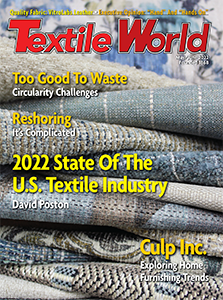CAMBRIDGE, England — June 9, 2022 — Although the fashion and textile industry is one of the most polluting on the planet, second only to oil and gas, consumers are unaware of its real impact on carbon emissions.
New research, commissioned by Alchemie Technology, UK innovator of low energy, waterless, textile dyeing technology, shows that just seven per cent of consumers think their clothes have the biggest impact on their carbon footprint.
When people were asked to list in descending order which sectors are most damaging to the environment, oil and gas emerged top (42 per cent ranked it as the biggest contributor to carbon emissions), followed by aviation and shipping (28 per cent), food (13 per cent), construction (8 per cent), and then fashion (7 per cent).
但是,时装业是世界上工业水污染的第二大原因 - 造成了全球碳排放量的百分之十,而不是国际航班和运输的总和。
Textile production uses huge quantities of water; 1.5 trillion litres annually. It takes 30 tonnes of water to dye one tonne of fabric, and many textile factories dump untreated dye contaminated wastewater directly into rivers.
Textile dyeing is the most damaging part of the textile supply chain, causing over three per cent of global CO2 emissions and more than 20 per cent of global water pollution. The global population buys 14kg of clothing per person on average each year, which creates 8,295 billion litres of wastewater and 553 million tonnes of CO2. UK consumers buy more, 26kg on average, which creates 131 billion litres of dye laden wastewater.
Alchemie技术的使命是通过改变纺织染色过程来减少时装业对环境的影响。
Dr. Alan Hudd, Founder of Alchemie Technology, said: “The fashion industry is one of the biggest polluters on our planet, and the process of dyeing the clothes we wear is the worst part of clothing production, responsible for 3 per cent of carbon emissions. If action isn’t taken now, it will make up 10 per cent of global carbon emissions by 2050. By changing the way fabric is dyed we can stop the industry producing 500 million tonnes of CO2 in the next eight years.”
Backed by fashion giant H&M and At One Ventures, Alchemie has developed a waterless digitally controlled dyeing technology, Endeavour, which produces no wastewater and reduces energy consumption by 85 per cent compared to traditional dyeing.
Despite not understanding the extent of the industry’s harmful impact, consumers are open to change. Alchemie’s poll of 2,004 consumers, which took place in April 2022, revealed that most people (59 per cent) are willing to pay more for clothes which have been made with less impact on the environment.
Almost half of UK consumers (43 per cent) think clothes should be labelled with a sustainability rating (like the food traffic light system), showing there is a public demand for clothes to carry information about how much water and energy has been used in their manufacture.
Two thirds of people (66 per cent) think the fashion industry should invest in new technology which reduces the environmental impact of dyeing clothes.
Dr. Alan Hudd, Founder of Alchemie Technology, said: “While there is already great awareness surrounding the issues of fast fashion and the amount of clothing going to landfill, there is still a long way to go to educate consumers on the extent of the fashion industry’s environmental damage.
“Our new research highlights how little understanding there is specifically around the damage of dyeing clothing. Yet, as our consumption of fast fashion is increasing every year, the production of those clothes, especially dyeing the fabric, uses vast amounts of energy and water.
“好消息是,可以很快取得巨大进展。如果品牌改用更可持续的染色方法,我们可以大大减少温室气体排放,但仍然享受具有相同质量的衣服。
“Alchemie’s Endeavour system is one way of achieving those goals. Our aim is to clean up the global dyeing industry and help the fashion sector to reduce its climate impact.”
发表:2022年6月9日
资料来源:炼金术技术




